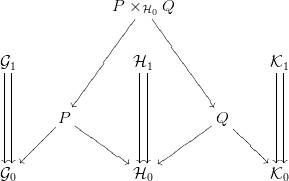Definition : Let $\mathcal{G}$ and $\mathcal{H}$ be Lie groupoids. A bibundle from $\mathcal{G}$ to $\mathcal{H}$ is a manifold $P$ together with two maps $a_L:P\rightarrow \mathcal{G}_0,a_R:P\rightarrow \mathcal{H}_0$ such that
there is a left action of $\mathcal{G}$ on $P$ with respect to an anchor $a_L$ and a right action of $\mathcal{H}$ on $P$ with respect to an anchor $a_R$.
$a_L:P\rightarrow \mathcal{G}_0$ is a principal $H$-bundle.
$a_R$ is $\mathcal{G}$ invariant.
the actions of $\mathcal{G}$ and $\mathcal{H}$ commutes.
I am trying to understand in what sense these are called generalized morphisms between Lie groupoids.
There is already a notion of generalized morphsim between Lie groupoids from Ieke Moerdijk's article Orbifolds as groupoids.
Definition : A generalized morphism from a Lie groupoid $\mathcal{G}$ to a Lie groupoid $\mathcal{H}$ is a morphism of Lie groupoids $\mathcal{G}'\rightarrow \mathcal{H}$ where $\mathcal{G}'$ is a Lie groupoid morita equivalent to $\mathcal{G}$.
The name generalized morphisms seems reasonable for this but I do not see in what sense a bibundle is said to be a generalized morphism.
Any comments that helps to understand in what sense bibundles are called as generalized morphisms are welcome.
Is it that given a bibundle there is a generalised morphism in the sense I have defined above and given a generalised morphism there exists a bibundle associated to that? I could not find any reference.
I am also not very comfortable/happy with the point that $a_R$ is just $\mathcal{G}$ invariant. I was guessing that the condition would be $a_R$ is a principal $\mathcal{G}$ bundle just similar to the second condition where it says $a_L:P\rightarrow \mathcal{G}_0$ is a principal $\mathcal{H}$ bundle. Is there any reason why the definition do not ask $a_R$ to be principal $\mathcal{G}$ bundle?? What is the speciality of just $a_L$?
I would be very comfortable even if the definition is just the following :
Definition : Let $\mathcal{G}$ and $\mathcal{H}$ be Lie groupoids. A bibundle from $\mathcal{G}$ to $\mathcal{H}$ is a manifold $P$ together with two maps $a_L:P\rightarrow \mathcal{G}_0,a_R:P\rightarrow \mathcal{H}_0$ such that
there is a left action of $\mathcal{G}$ on $P$ with respect to an anchor $a_L$ and a right action of $\mathcal{H}$ on $P$ with respect to an anchor $a_R$.
$a_L$ is $\mathcal{H}$ invariant
$a_R$ is $\mathcal{G}$ invariant.
the actions of $\mathcal{G}$ and $\mathcal{H}$ commutes.
To make sense of question of action of $\mathcal{G}$ and $\mathcal{H}$ being commuttaive, it is just sufficient to have $a_R(g.p)=a_R(p)$ and $a_L(p.h)=a_L(p)$. The definition of bibundle given is none of what I have expected. It is somewhere in between. What is the significance there?
Any comments are welcome.
https://ncatlab.org/nlab/show/bibundle says,
A bibundle is a groupoid principal bundle which is equipped with a compatible second groupoid action “from the other side”.
I am somehow ok with this definition. But the question of seeing bibundles as generalized morphisms is still not clear.
EDIT : It says in Page no $12$ of Orbifolds as stacks? that, to a $\mathcal{G}-\mathcal{H}$ bibundle $P$ one can associate a functor $\{\mathcal{G}-bundles\}\rightarrow \{\mathcal{H}-bundles\}$. Is this can be the reason for calling bibundles as generalized morphism where morphism of $\mathcal{G}$ to $\mathcal{H}$ is just a morphism of Lie groupoids $\mathcal{G}\rightarrow \mathcal{H}$ where as if you go one step above the ladder you have category of $\mathcal{G}$ bundles and your bibundle map is giving a morphism in that above step. Am I misunderstanding something here?
Just for convenience, I am attaching diagram

